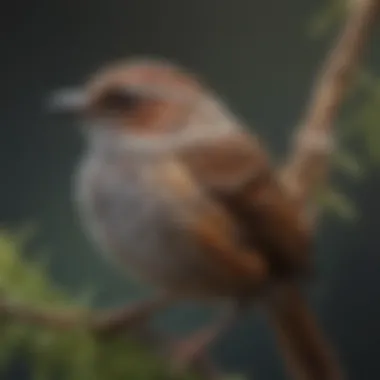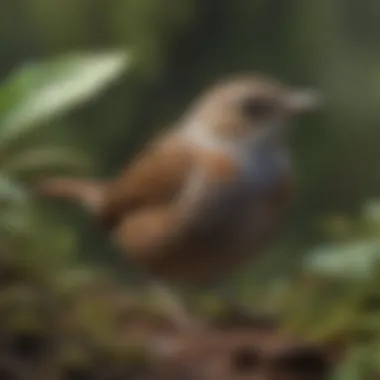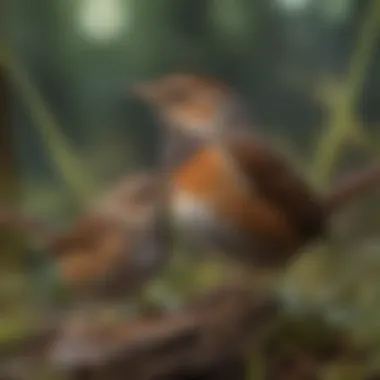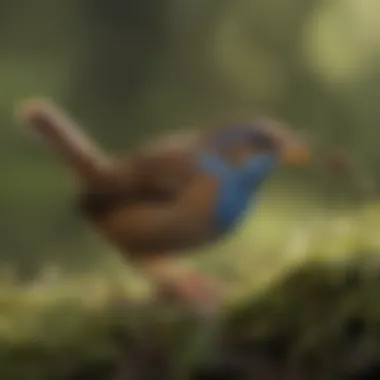Exploring the Unique Traits of Wrens


Intro
Wrens are small, energetic birds known for their unique characteristics and behaviors. These birds belong to the family Troglodytidae and are found in various parts of the world. The aim of this article is to explore the distinct traits that define wrens, encompassing their physical attributes, behaviors, and habitats. By examining the different species and their roles within ecosystems, we aim to foster appreciation for these captivating creatures.
Animal Overview
Common Name and Scientific Classification
The term "wren" commonly refers to various species within the family Troglodytidae. This family comprises around 75 species, with the most recognizable being the House Wren (Troglodytes aedon) and the Marsh Wren (Cistothorus palustris). Different species exhibit a range of sizes and adaptations, but they share key traits that mark them as wrens.
Physical Characteristics
Wrens are typically small, measuring about 3 to 6 inches in length. They have a compact body, short tails, and a distinctively curved bill. Their coloration can vary widely, often featuring a mixture of brown, gray, and streaked patterns, which provide effective camouflage in their natural habitats. For example, the Carolina Wren (Thryothorus ludovicianus) showcases a warm rufous color with a distinctive white eyebrow stripe.
Habitat and Distribution
Wrens thrive in diverse environments, including forests, grasslands, wetlands, and even urban areas. They are mainly distributed across North and Central America, with some species residing in South America and parts of Europe and Asia. Their adaptability to different habitats allows them to bob between shrubs, underbrush, and even human structures.
Behavior and Social Structure
Communication Methods
Wrens are known for their vocalizations, which vary between species. They produce a range of calls, including melodious songs and sharp chattering sounds. These calls serve various functions, such as attracting mates, defending territory, and communicating with flock members.
Social Hierarchies
Many wren species are known to exhibit social behaviors. Some, like the Eurasian Wren (Troglodytes troglodytes), may form loose flocks, especially outside the breeding season. However, they tend to be territorial during nesting, defending their chosen sites with vigor.
Mating and Reproductive Behavior
Wrens display interesting courtship rituals. Male wrens often build several nests and exhibit their capabilities to attract females. After selecting a mate, they typically form monogamous pairs for the breeding season. The female does most of the nesting duties, laying eggs usually within a concealed site, providing a safe environment for the young.
Conservation Status
Current Population Trends
The conservation status of wrens varies by species. While some, like the House Wren, are widespread and abundant, others have experienced declines due to habitat loss and environmental changes.
Threats and Challenges
Habitat destruction, climate change, and competition with introduced species pose significant threats to wrens. Urban development can reduce their habitat, impacting their survival.
Conservation Efforts and Success Stories
Conservation efforts focus on protecting habitats and raising awareness about the importance of maintaining biodiversity. Organizations are working on various initiatives to monitor populations and promote appropriate land management practices to safeguard these birds.
Wrens play an essential role in ecosystems by controlling insect populations and serving as indicators of environmental health.
Through this exploration, we gain a deeper understanding of wrens, emphasizing their distinct characteristics and the pressing need for conservation.
Prologue
The study of wrens is more than just an exploration of another bird species. Wrens possess distinctive characteristics that set them apart within the avian world. These small, energetic birds offer a variety of traits worth examining. From their unique physical features to their diverse behaviors and habitats, wrens are a compelling subject for those interested in ornithology and wildlife.
In this initial section, we highlight the importance of wrens in biodiversity and their adaptability to various environments. Their varied songs, foraging methods, and nesting behaviors reveal their resilience. These elements make them a focus for veterinarians, wildlife biologists, and families alike, who seek to understand the fluid dynamics between species and their habitats.
Through this exploration, readers will come away with a more nuanced view of wrens, encouraging interest and future conservation efforts. The intricate characteristics of these tiny birds contribute greatly to the ecosystem, and this article seeks to uncover that complexity.
Overview of Wrens
Wrens are small, energetic birds known for their lively personalities and distinctive songs. This article examines the many facets of wrens, focusing on their diverse species, behaviors, and physical characteristics. Understanding wrens contributes to a greater appreciation of avian diversity and the roles these birds play in ecosystems.


Importance of Studying Wrens
Studying wrens is significant due to their adaptability and presence in various habitats. Their behavior and physical traits make them interesting subjects for both casual bird watchers and professional ornithologists. By observing wrens, one can gain insights into ecological balance and the health of their respective environments.
The various species of wrens exhibit a range of behaviors and adaptations that enable them to thrive in specific conditions. For instance, the House Wren is versatile and can be found in urban areas, while the Cactus Wren prefers arid regions. Recognizing these differences highlights the impact of environmental factors on species survival.
Benefits of Learning About Wrens
Here are some reasons understanding wrens is beneficial:
- Ecosystem Health: Wrens often serve as indicators of environmental quality. Their presence or absence can signal changes in habitat health, benefiting conservation efforts.
- Biodiversity Awareness: Exploring wren species encourages appreciation for diverse avian life. This can inspire conservation efforts and an interest in natural habitats.
- Community Engagement: Wrens can foster community interest in wildlife. Educational initiatives focusing on local wrens can enhance community involvement in conservation activities.
Considerations Regarding Wrens
When studying wrens, it is important to consider the following aspects:
- Threats to Habitat: Urbanization and habitat destruction pose significant risks to wren populations. Recognizing these threats is crucial for effective conservation strategies.
- Behavioral Adaptations: Wrens exhibit various adaptations to survive in differing conditions. Understanding these behaviors can inform habitat management practices.
- Conservation Efforts: Increased knowledge about wren species can support targeted conservation initiatives aimed at protecting these birds and their habitats.
The study of wrens not only enhances our knowledge of these unique birds but also informs broader environmental and conservation efforts.
In summary, an overview of wrens encompasses their ecological significance, adaptive features, and the issues they face in their habitats. This understanding contributes to the overall narrative of avian conservation and the vital roles that these small birds play in their ecosystems.
Physical Features of Wrens
Understanding the physical features of wrens is crucial for appreciating these birds and their adaptations. Physiology greatly impacts their behavior, survival, and interactions within their habitats. Each characteristic contributes to their unique identity among avian species. The size, coloration, and beak structure facilitate various functions ranging from foraging to communication.
Size and Dimensions
Wrens are generally small birds, often measuring between 4 to 6 inches in length. Their diminutive size aids in their agility as they navigate through dense vegetation. Such dimensions allow them to access food sources that larger birds may overlook. However, size can vary among different species, with the Carolina Wren being on the larger end of the spectrum. This variation in size is essential for their survival as it defines their ecological niche. Smaller wrens may be more adept at slipping through tight spaces when searching for insects or insects' nests.
Coloration and Patterns
The coloration of wrens often includes a mix of browns, grays, and whites. This muted palette serves as effective camouflage against predators in their natural environment. Specific species have distinct markings; for example, the House Wren exhibits a series of fine, dark stripes across its back, which further aids in hiding among foliage. The subtlety in their colors is not just for protection but also plays a role in mating rituals. Bright or contrasting colors can signal health and vitality to potential mates.
Beak Structure
Wrens possess slender, pointed beaks, adapted for their insectivorous diet. This structure enables them to probe into crevices and extract food such as insects, spiders, and seeds. The beak serves another purpose in their social behavior, as it is integral to their vocalizations. Wrens communicate through a complex array of sounds, and the shape of their beaks helps produce these diverse calls. In essence, beak structure is fundamental in both feeding and interactive contexts, marking its importance in their everyday life.
Wrens illustrate the profound connection between physical features and their ecological roles, showcasing how adaptations drive survival in varying environments.
Common Species of Wrens
Understanding the common species of wrens is vital in grasping the full spectrum of characteristics that define this group of small, vocal birds. Each species presents unique traits, behaviors, and habitats, enriching the overall picture of wrens. Highlighting these species allows readers to appreciate the adaptability and ecological significance of wrens, as well as their variations. This section will explore the House Wren, Carolina Wren, and Cactus Wren, each of which contributes significantly to their environments and offers distinct features worth noting.
House Wren
The House Wren, scientifically known as Troglodytes aedon, is widely recognized for its remarkable adaptability to urban environments. Measurement-wise, this species typically ranges from 4.5 to 5.5 inches in length, making it one of the smaller wrens. Its plumage usually features a brownish color, marked with darker streaks.
House Wrens have a distinctive habit of exploring various nooks and crannies for nesting sites. They can often be found in backyards, parks, and gardens. When they create their nests, they usually use twigs, grass, and even garbage, showing their resourcefulness. Their vocalizations are complex and varied, making them some of the most enthusiastic singers among birds.
Carolina Wren
The Carolina Wren, known by its scientific name Thryothorus ludovicianus, is particularly famous for its loud, cheerful song. This species is slightly larger than the House Wren, typically about 4.5 to 5.8 inches in length. It exhibits a rich chestnut color on its back, with a paler underbelly, distinguishing it from other wrens.
Carolina Wrens prefer humid environments, often associating with thickets or partially wooded areas. Their nesting behavior is also of interest; they frequently choose protected spots like tree hollows or dense shrubs. They are highly protective of their territories, and their presence is often marked by their unmistakably loud calls. Observing these birds can provide insights into local ecology, especially their roles as insectivores.
Cactus Wren
Cactus Wren, scientifically termed Campylorhynchus brunneicapillus, holds the title of the largest North American wren. Measuring about 7.5 to 9 inches, this species exhibits an array of colors, mainly brown with black and white streaks. Its distinct appearance is complemented by its preference for arid desert habitats, particularly where cacti are plentiful.
These wrens build their nests within the protective spines of cacti, making them less accessible to predators. Their behavior is a fascinating blend of resilience and adaptation to harsh conditions. Cactus Wrens often forage for insects and seeds among desert flora, thus playing a critical role in the ecosystem.
Behavioral Characteristics
Understanding the behavioral characteristics of wrens offers insights into their adaptation and survival strategies. These behaviors are not just fascinating; they play a vital role in their daily lives and interactions with their environment. Knowing how wrens vocalize, forage, and breed provides a richer appreciation for their ecological niche and importance.
Vocalization Patterns


Wrens are renowned for their distinct vocalizations. They produce a variety of songs, which serve multiple functions. Primarily, these calls are used for mating purposes. Males sing to attract females and establish territory. The complexity and variation in a male’s song can indicate its fitness.
Their vocal range includes melodious trills and rapid sequences, which resonate throughout their habitats. For instance, the Carolina Wren's song is a sweet and loud series of notes that can travel great distances.
Furthermore, different vocalizations can signal alarms to alert others of predators. This communication is crucial for survival and maintaining social structure within their groups.
"The vocal abilities of wrens are not merely for show; they are integral to their survival and reproductive success."
Foraging Habits
Wrens exhibit unique foraging behaviors, primarily focusing on insects and other small invertebrates. They are often seen flipping over leaves, probing into crevices, or hunting through dense foliage. Their foraging style is energetic and exploratory, which allows them to cover ground efficiently.
During foraging, wrens demonstrate significant adaptability. They utilize various techniques depending on the resource availability. For example, the House Wren is known to forage on the ground and in bushes, often taking advantage of different layers within their habitat.
Their keen eyesight aids in spotting food. Wrens are also known to feed on fruits and seeds when insects are scarce, showcasing their opportunistic nature. Their foraging habits significantly impact the insect populations, making them essential to their ecosystems.
Nesting and Breeding
Nesting behaviors of wrens are fascinating and diverse, reflecting their adaptability. Most wrens construct their nests in hidden locations, often using dense vegetation for concealment. The House Wren may take advantage of artificial structures such as old boxes or crevices in human buildings, showcasing their resourcefulness.
During the breeding season, males perform elaborate displays to attract mates. This may include vocalizations as well as showing off their nesting sites. Once paired, the female typically does the majority of nest building, meticulously collecting materials such as twigs, grass, and feathers.
The typical clutch consists of multiple eggs, and both parents often help in rearing the young. This shared responsibility not only strengthens pair bonds but also ensures higher survival rates for their chicks. The successful nesting and rearing of young are vital for sustaining wren populations across seasons.
Habitat and Distribution
Understanding the habitat and distribution of wrens is crucial for comprehending their adaptability and ecological roles. Wrens tend to occupy diverse environments, ranging from wooded areas to urban settings. By examining the habitats they prefer, we can derive insights into their behavior, feeding habits, and breeding patterns. Furthermore, knowing their geographical distribution helps us recognize which species are present in specific regions and highlights conservation needs, especially in areas facing habitat loss or degradation.
Preferred Habitats
Wrens display a remarkable versatility in adapting to their surroundings. They are commonly found in:
- Deciduous forests: These areas offer dense vegetation, which provides ample cover and nesting opportunities.
- Shrubby habitats: This includes overgrown fields and brushy areas, good for foraging for insects and seeds.
- Wetlands: Many species are attracted to marshes where they can find abundant food sources.
- Urban settings: Surprisingly, wrens thrive in cities where they use gardens, parks, and even balconies as nesting sites.
These habitats share key features that wrens exploit. Dense foliage provides protection from predators, while diverse food sources are essential for their survival. Many wren species prefer habitats near water sources, as this aids their foraging and nesting activities. Some wrens, like the House Wren, have adapted well to human environments, showcasing their resilience.
Geographical Distribution
The geographical distribution of wrens is extensive, with various species found across the Americas and beyond. Notable points include:
- North America: The House Wren and the Carolina Wren are prevalent across much of the continent, showcasing adaptability to various climates.
- Central America: The Cactus Wren is more specific to desert environments, impressively blending into its surroundings.
- South America: A wider variety of wren species can be found in the lush ecosystems.
Important Point: Various factors, including climate and vegetation, influence where different wren species thrive. Each wren's habitat preferences are honed to maximize their chances of survival.
The presence of wrens in a given geographical area can be an indicator of environmental health. Monitoring their populations may reveal changes in habitat conditions or the impacts of climate change. Recognizing these patterns allows for better conservation strategies and habitat preservation efforts.
Wrens in Ecosystems
Understanding the role of wrens in ecosystems sheds light on their significance beyond mere aesthetics. These small birds contribute to the balance of their environments in various ways. By examining their feeding habits, nesting behaviors, and interactions with other species, we can appreciate how crucial they are to maintaining ecological harmony.
Role in the Food Web
Wrens occupy a unique position in the food web. They are primarily insectivores, meaning they feed on insects, spiders, and other small invertebrates. This feeding behavior helps control pest populations, which can benefit plants and agriculture. The presence of wrens can indicate a healthy insect population; they often choose habitats with abundant food sources. When they feed, they help disperse seeds and control the spread of certain species, contributing to plant diversity.
Moreover, wrens serve as prey for larger predators. Their small size makes them targets for birds of prey as well as terrestrial predators, including snakes. This predation is integral in keeping their populations in check and provides food for other species, further embedding them in the complex web of life.
Interactions with Other Species
Wrens demonstrate remarkable adaptability through their interactions with other species. They often share habitats with species like sparrows and chickadees, which can lead to competition for resources. However, instead of direct competition, these interactions may result in a balance where different birds exploit varied niches based on their preferences for food or shelter.
These birds are also known for their nesting habits. Many wrens build their nests in locations that provide safety from predators. They may use abandoned nests of other birds or create their own in dense bushes. This behavior not only ensures their reproductive success but also illustrates their cooperative nesting tendencies.


- Wrens often participate in mixed-species flocks, increasing their foraging efficiency.
- They may occasionally follow larger foraging birds to take advantage of disturbed insects.
The interactions of wrens with flora are equally important. As they search for food, they contribute to pollination and the dispersal of seeds, allowing plants to thrive in various environments. In this way, wrens support the health and resilience of their ecosystems.
The presence of wrens often indicates a thriving ecosystem, illustrating their essential role in the balance of nature.
Conservation Status
The conservation status of wrens is essential to understanding how human activities and environmental changes impact these unique birds. As they play a vital role in ecosystems, monitoring their populations allows researchers and conservationists to assess the health of various habitats. The decline in wren populations can indicate broader ecological problems, urging the need for proactive measures. Therefore, focusing on their conservation status is necessary to ensure the protection of these species and their habitats.
Threats to Wren Populations
Wrens face numerous threats that jeopardize their survival. One major concern is habitat loss due to urban development and land conversion for agriculture. These birds often depend on dense shrubs and woodlands for nesting and foraging. Another significant threat is climate change, which alters their habitats and food sources. Extreme weather patterns can lead to harsh conditions that make survival difficult.
Moreover, predation by domestic cats and habitat competition from invasive species further contribute to the decline in wren numbers. Pollution, particularly from pesticides and herbicides, can also impact their health and reproductive success. These factors combined create a challenging environment for wrens, underscoring the need for attention to their conservation status.
Conservation Efforts
In response to the threats faced by wrens, several conservation efforts have been initiated. Organizations focus on habitat restoration and protection to create safe environments for these birds. Preserving native plants can enhance food supply and cover necessary for nesting.
Monitoring programs are also essential in tracking wren populations, allowing professionals to identify trends and assess the effectiveness of conservation strategies. Public education and community involvement play a significant role, empowering individuals to contribute to wren conservation.
"The survival of wrens is not just about saving a species; it's about maintaining the delicate balance of our ecosystems."
Additionally, legislation aimed at protecting critical habitats ensures that the areas wrens depend on remain intact. Creating wildlife corridors can help connect fragmented habitats, facilitating movement between populations. All these efforts combined are a step toward securing the future of wrens in the wild.
Closure
Understanding the characteristics of wrens is crucial for various audiences, from wildlife biologists scrutinizing their roles in ecosystems to families observing these birds in their local environment. For veterinarians, knowledge about the health and well-being of wrens can inform care practices and conservation efforts.
The diverse species of wrens exhibit different behaviors which can be quite fascinating. For example, the vocalizations unique to each species illustrate their complex social structures. Similarly, their foraging habits reveal not just survival strategies but also play a role in maintaining the health of their habitats.
Moreover, the discussion around conservation highlights the threats wrens face. Thus, it positions readers to consider their role in advocating for these birds, ensuring that both familiar and rare species continue to thrive. This awareness can lead to community engagement in preservation activities.
Summarizing, this article ultimately aims to nurture an appreciation for wrens. Their traits, behaviors, and contributions to environmental stability are key components that warrant attention. By recognizing their importance, we foster conservation efforts that benefit not just the wrens themselves but the broader ecosystem they inhabit.
Understanding the role of wrens in ecosystems can illuminate the interconnectedness of all species, reinforcing the need for conservation efforts.
Benefits of Referencing
- Enhanced Credibility: Readers tend to trust articles backed by sound references. This trust is crucial when discussing species that may be endangered or require special conservation efforts.
- Additional Resources: References guide readers towards more extensive materials, which can be especially beneficial for veterinarians or wildlife biologists seeking detailed information.
- Support for Claims: When discussing specific behaviors or characteristics of wrens, references provide the evidence needed to support such claims, preventing misinformation.
"Resources such as Encyclopedia Britannica and Wikipedia can serve as non-specialized introductions to further studies."
Considerations for Effective References
When citing references, it is important to adhere to the following considerations:
- Select current publications where possible, ensuring that the science is up-to-date.
- Prioritize peer-reviewed articles, as they undergo rigorous examination before publication.
- Include a mix of local and global sources to provide a well-rounded view of wren populations in various environments.
Importance of Additional Resources
Accessing quality additional resources can deepen your understanding of wrens by:
- Providing Detailed Species Information: Guides and databases often offer in-depth descriptions of individual wren species, their habitat preferences, breeding habits, and vocal patterns.
- Offering Field Guides: Many field guides specifically related to birds provide visual aids for identification purposes, which is beneficial for amateur birdwatchers and professionals alike.
- Highlighting Conservation Efforts: Resources focused on conservation can shed light on the current status of wren populations and ongoing efforts to protect their habitats. Insights like these are vital for conservationists.
- Facilitating Community Engagement: Platforms such as Reddit or Facebook groups where enthusiasts share their observations and experiences can lead to community learning and appreciation for these birds.
Key Elements to Consider
When searching for additional resources, consider the following:
- Credibility: Ensure that the information comes from reputable sources, like scientific journals, dedicated ornithological organizations, and established educational sites such as Britannica or Wikipedia.
- Update Frequency: Wildlife data can change rapidly due to conservation efforts and environmental shifts. Look for resources that are regularly updated to reflect current knowledge.
- Diversity of Perspectives: Engaging with various types of resources (articles, videos, forums) can provide a holistic understanding of wrens. Different perspectives lead to richer learning experiences.
"Knowledge is power when it comes to appreciating the complexities of nature. By utilizing reliable resources, one can truly grasp the beauty and significance of wrens within their ecosystems."
Suggested Additional Resources
Harnessing these additional resources can significantly augment the insights gained from this article. By doing so, readers can keep informed and engaged with the world of wrens, enhancing their appreciation and understanding of these remarkable birds.







